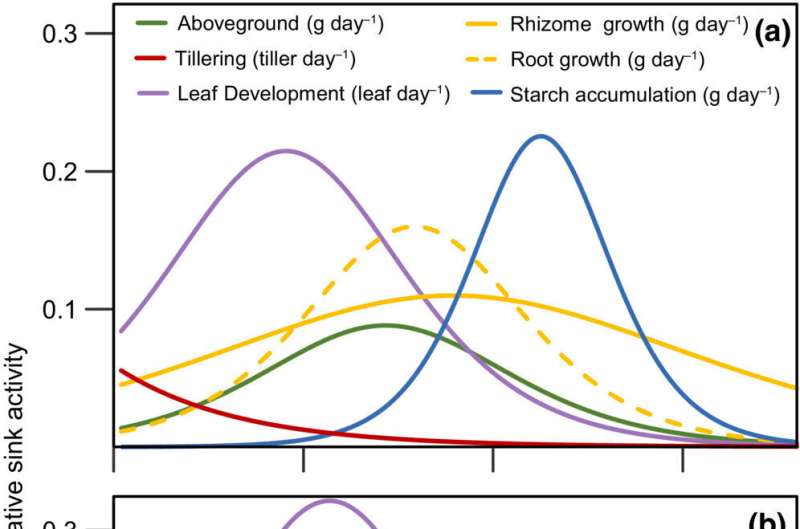This article has been reviewed according to Science X's editorial process and policies. Editors have highlighted the following attributes while ensuring the content's credibility:
fact-checked
peer-reviewed publication
trusted source
proofread
What happens to switchgrass when food reserves are depleted?

As potential for biofuel, switchgrass is a perennial plant that is of great interest to researchers. Scientists from the MSU-DOE Plant Research Laboratory Walker lab are looking at how these plants regrow, even when regrowing with less than its usual carbon storage.
Perennials are plants that will come back in the spring, unlike annuals which die after one growing season. In order for perennials to come back, they need to store enough food for the winter, like a bear getting ready for hibernation by gorging itself on fish.
In a previous study, researchers from the Walker lab looked at what stops switchgrass from growing. Why do these grasses reach a certain size and stop in the middle of summer? What's to keep them from growing indefinitely?
One limiting factor was the environment they are grown in and how it changes during the season. If a plant has more access to resources like sunlight and water, it can grow more. Interestingly, when researchers compared rainfed plants with plants under a shelter that received no water for the entire season, they found that both groups stopped growing at the same time.
"What we found was that at some point, when the reserves get full, the plant shuts down," said Mauricio Tejera-Nieves, postdoctoral researcher in the Walker lab and lead author of this study.
Like the bear getting ready for hibernation, plants need somewhere to put all the carbohydrates they produce during photosynthesis. The bear has its fat, the plant has roots.
Finding that the pantry gets full was the first step. A follow-up paper, published in GCB-Bioenergy, looks at what happens to switchgrass when its carbohydrates reserves are purposefully depleted by 30%.
The researchers looked at switchgrass's rhizome, or rootstalk, where carbon reserves are held. The rhizomes were kept at a slightly higher temperature, forcing it to burn more of the carbohydrate reserves to stay alive, a bit like having to idle a car to keep the air conditioner running. 30% of the carbon reserves were burnt this way. This technique of using temperature to deplete reserves is novel to this study.
The depleted rhizomes were grown and compared to control ones that were held at low temperature.
Despite starting with a penalty, the 30% depletion of carbon reserves did not affect the final size of the plant, and it was able to restock up on its reserves by the end of the growing period.
"What we found was that, after we let them grow over almost six months, the ones with the depleted reserves reached almost the same biomass as the [control] plants," Tejera-Nieves said. The treated plants, "also started with a depleted supply of starch. When we measured the starch content at the end, they had the same amount of starch that the control had."
Over the growing period, the switchgrass needed to store enough carbon for its anticipated hibernation and make up for the 30% less that it started with. To make that possible, the switchgrass needed to up its rate of photosynthesis.
"The whole plant was doing more photosynthesis. Not by increasing the output of each individual leaf, but by adding more leaves," Tejera-Nieves said.
The switchgrass produced more tillers, or stems, from which it grew more leaves. More leaves means more surface area where the switchgrass can capture sunlight for photosynthesis.
"This work is interesting because it shows that these plants over-invest in what they need to regrow the next year," said Berkley Walker, assistant professor at the PRL and in the Department of Plant Biology. "One could imagine that they could use this extra carbon that they are storing for higher growth instead and result in a better biofuel crop."
Switchgrass has excellent potential as a biofuel crop. It is low-cost and low-maintenance, and it is native to North America, including Michigan.
If the researchers can discover the mechanisms that make the plants slow down growth and photosynthesis, it could be possible to manipulate that biological response to have plants with an unending appetite and maintain photosynthesis throughout the season, even when they have enough carbon to last the winter. Higher photosynthesis for longer in the season will mean more biomass and potentially more biofuel.
"What I like about [perennial grasses] is the potential ecological and social impacts that we will have with switchgrass," Tejera-Nieves said. "I do believe we can have a better world by putting perennial grasses in the landscape."
More information: Mauricio Tejera‐Nieves et al, A 30% reduction in switchgrass rhizome reserves did not decrease biomass yield, GCB Bioenergy (2023). DOI: 10.1111/gcbb.13094
Journal information: GCB Bioenergy
Provided by Michigan State University

















